Spinal Canal Stenosis
What is Spinal Canal Stenosis?
Spinal canal stenosis is the narrowing of one or more areas inside the spinal canal. The spinal canal is the pathway that connects each vertebra in your spine. It contains your spinal cord. A decrease in space within your spinal canal constricts your spinal cord and the nerves that arise from it (nerve roots).
Your spinal cord or nerves may become inflamed, crushed, or squeezed as the space narrows. This can lead to back pain and sometimes compress the nerve, such as sciatica. A restricted spinal canal can be caused by a number of illnesses and events.
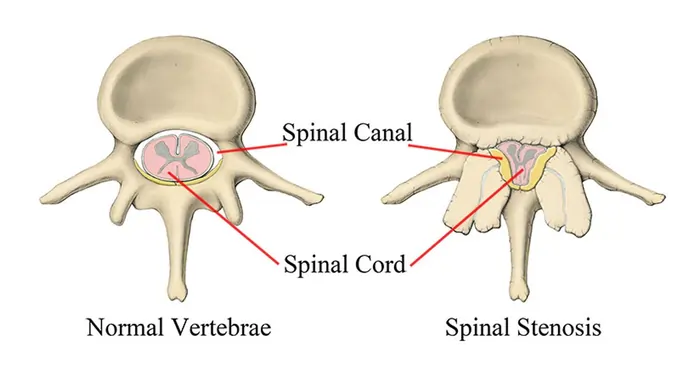
The disorder mostly affects two parts of your spine which are the cervical and lumbar spine it rarely affects the thoracic spine.
- Neck (cervical spinal stenosis): Your cervical spine has 7 vertebrae in your neck. C1 through C7 are the vertebral numbers.
- Lower Back (Lumbar Spinal Stenosis): Your lumbar spine is made up of five bones (vertebrae) in your lower back. Your lumbar vertebrae, L1 through L5, are the largest in your entire spine. The lower back accounts for approximately 75% of all spinal stenosis cases.
- Mid back (thoracic stenosis): your thoracic spine area consists of 12 vertebrae in your mid back which are known as T1 to T12. it is far less than the 2 other types because the rib cage keeps this area of the back more stable and limited in terms of movements.
- Spinal stenosis can also occur in the thoracic spine, however, this is rare.
How common is spinal stenosis?
Spinal stenosis is rather frequent. Up to 95% of persons over the age of 50 have degenerative spinal problems. Spinal stenosis is one of these alterations. Lumbar spinal stenosis is the most common diagnosis for those over the age of 65 who require spine surgery.
Spinal canal stenosis can affect anybody; however, it mostly occurs over the age of 50 people.
What are the 4 stages of Spinal Stenosis?
The four phases are:
- Stage 1: Dysfunction, in which the spine loses protection from shock, and you may experience slight discomfort.
- Stage 2: Dehydration stage, in which you continue to lose function and may feel considerable pain.
- Stage 3: Stabilisation stage, when spinal stenosis begins and you may experience considerable discomfort.
- Stage 4: Collapsing stage, in which the spinal discs may collapse, causing extreme discomfort, and severe pain.
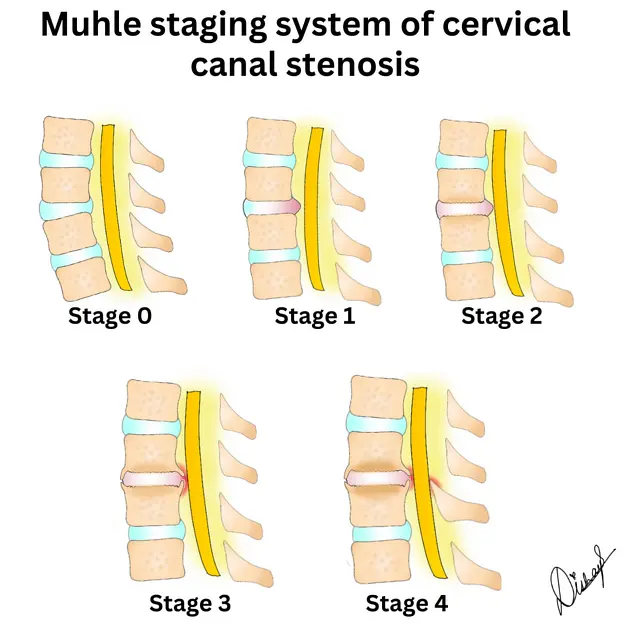
What are the symptoms of spinal stenosis?
Depending on the severity and area involved, you may have the following symptoms in your neck, back, arms, legs, hands, or feet:
- Pain
- Numbness.
- Tingling.
- Weakness.
- discomfort
- burning pain
Symptoms of lumbar spinal stenosis
Symptoms of lumbar (low back) spinal stenosis are:
- Pain in your lower back.
- pain that starts in your buttocks and spreads down your leg
- A heavy feeling in your legs may lead to cramping in one or both legs.
- Your buttocks, leg, or foot may feel numb or tingly (“pins and needles”).
- Pain that worsens when you stand for long periods, walk, or walk downhill.
Symptoms of cervical spinal stenosis
Cervical spinal stenosis symptoms can be felt anywhere below the location of nerve compression in your neck. The symptoms include:
- Neck pain.
- Feeling numb or tingling in your arm, hand
- Weakness or clumsiness in your arm, hand
- Balance problems.
- Impaired hand function, such as difficulties writing or buttoning clothing.
what are the complications of spinal stenosis?
The pain caused by spinal canal stenosis is a chronic condition that can highly impair quality of life. However, this spine ailment can develop into additional issues, such as muscular weakness, which impairs balance and walking.
Other problems of spinal stenosis include:
- Decreased hand function
- Loss of bowel or bladder control.
- Sexual dysfunction.
- Partial leg paralysis.
These problems are the result of nerve compression caused by spinal canal narrowing. If you experience chronic neck or back discomfort, or any of the problems listed above, get expert medical attention for treatment. Early management may help decrease the course of your symptoms.
In extreme cases, spinal stenosis may result in loss of bladder or bowel control (incontinence). Nerve disorders can lead to sexual dysfunction, including erectile dysfunction and anorgasmia.
In rare situations, spinal stenosis can result in partial or full limb paralysis.
What causes spinal stenosis?
The causes are classified into two primary categories:
- Acquired (developing after birth).
- Congenital (from birth).
It is mostly caused by “wear and tear” alterations that occur naturally in your spine with aging. Only 9% of cases are due to congenital factors.
Acquired causes of spinal stenosis
Acquired spinal stenosis occurs later in life (after birth), often beyond the age of 50. These situations are frequently caused by an accident or changes in your spine as you age (degenerative alterations).
Causes of acquired spinal stenosis include:
- Osteoarthritis is a “wear and tear” disease that leads to cartilage breakdown in your joints and also affects your spine. Cartilage is the protective coating for joints. As your cartilage travels downward, your bones begin to stroke together. Your body responds by growing new bones. Bone spurs on your vertebrae grow into your spinal canal, narrowing it and squeezing nerves in your spine. Paget’s disease can also lead to bone growth in the spine. Wear and tear from arthritis can cause additional bone to form on the spine. These are called bone spurs. They are able to press into the spinal canal.
- Bulging or herniated disks: Bulging or herniated discs: Each vertebra has a flat, circular cushioning pad (vertebral disc) that serves as a shock absorber. As you age, the discs may dry up and flatten. The bulging disc then pushes on the nerves near it. Discs are soft cushions that act as shock absorbers between two vertebrae. If any of the disc’s soft inner material spills out, it might put pressure on the spinal cord or nerves.
- Thickened ligaments: Ligaments are connective tissues that hold your spine together. Arthritis causes ligaments to imflammed, thicken, and protrude into the spinal. The strong cords that connect the bones of your spine can stiffen and thicken with time. Thick ligaments may bother into the spinal canal.
- Spinal fractures and injuries: Broken or dislocated bones in your vertebrae or around your spine might reduce the canal space. Inflammation from injuries around the spine might also create problems. Car accidents and other trauma can cause spinal bones to fracture or shift out of place. Swelling of nearby tissue after back surgery may create stress on the spinal cord or nerves.
- Spinal cysts or tumors: Growths within or between your spinal cord and vertebrae have a chance to restrict your spinal canal.
Congenital causes of spinal stenosis
Congenital spinal stenosis affects babies and children. It can happen due to:
- Issues with spine formation during fetal development.
- Genetic (inherited) conditions that affect bone growth. These result from genetic alterations (changes).
Some congenital causes of spinal stenosis include:
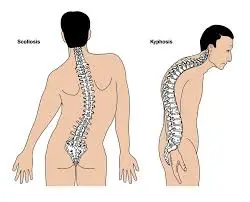
- Achondroplasia: A growth of bone problem caused by a hereditary mutation, resulting in dwarfism.
- Spinal dysraphism: When the spine, spinal cord, or nerve roots fail to grow correctly during fetal development. such as spina bifida.
- Congenital kyphosis: When your child’s spine bends outward more than it should. As a result, their upper back seems abnormally round. This is related to difficulty with fetal spine development.
- Scoliosis: If you have scoliosis or other spinal abnormalities, you may be more likely to develop spinal stenosis as you age.
- Congenital short pedicles: When a child is born with shorter vertebral pedicles (bony “sides” of the spinal canal)This decreases the size of the spinal canal.
- Osteopetrosis: An uncommon hereditary disorder that causes your child’s bones to develop improperly and become excessively thick.
- Morquio syndrome: it is a rare genetic disease that affects your child’s bones, spine, and other bodily functions.
- Hereditary multiple exostoses (diaphyseal aclasis) are an uncommon hereditary disorder that results in numerous tiny bone growths (protrusions). They can affect a child’s vertebrae and reach the spinal canal.
How is spinal stenosis diagnosed?
Your physician will assess your medical history, question about your symptoms, and do a physical examination. The physician may feel your spine and push on different areas to see whether it causes discomfort. They will most likely ask you to bend in various ways to see whether certain spinal positions create issues.
You will also have imaging tests performed so that your doctor can “see” your spine and determine the exact spot, type, and severity of the disease. These tests can include:
- Spine X-ray: X-rays use a minimal quantity of radiation and can detect changes in bone structure. for example, They can indicate disc height reduction or bone spurs.
- MRI: MRI provides detailed images of your nerves, disks, and spinal cord. It can also show tumors.
- CT scan or CT myelogram: A computed tomography (CT) scan is a sequence of X-rays that create cross-sectional images of the spine. A CT myelogram uses contrast dye to help your doctor examine your spinal cord and nerves.
Treatment
There are many treatment options for spinal stenosis. What’s best for you depends on:
- The cause.
- The location of the issue.
- The severity of your symptoms.
If your symptoms are minimal, your doctor may first recommend at-home care. If these methods fail and symptoms worsen, your doctor may recommend physical therapy, medications, injections, and, eventually, surgery.
Medications
Your physician provider might prescribe:
- Nonsteroidal anti-inflammatory drugs (NSAIDs). If over-the-counter pain medications do not help to relieve pain, prescription NSAIDs may be helpful.
- Antidepressants. Tricyclic antidepressants can be prescribed to help with chronic pain.
- Anti-seizure drugs. Some seizure medications, such as gabapentin (Neurontin, Gralise), are used to alleviate pain caused by injured nerves.
- Topical Analgesics: creams, gels, or patches that include drugs such as lidocaine or capsaicin that can be applied directly to the painful spot to offer localized pain relief.
- Opioids. Medications such as oxycodone (Oxycontin, Roxicodone, and others) and hydrocodone (Hysingla ER) can be habit-forming.
- Steroid injections: Your nerve roots may become inflamed and swollen where they are pinched. Injecting a steroid drug into the area surrounding the pinched nerve may help decrease inflammation and alleviate some discomfort. However, steroid injections may not be the best way to manage spinal stenosis. According to some research, combination steroids and numbing injections cure back pain no better than numbing medication shots alone. This is significant since steroids can have substantial adverse effects. Steroid injections given repeatedly might damage adjacent bones, tendons, and ligaments. As a result, patients may have to wait many months before receiving another steroid injection.
Physical Therapy Treatment
Physical therapists will help you build a back-healthy workout program.
- decrease discomfort and pain,
- gain strength, and
- improve your balance,
- flexibility, and
- spine stability.
- Strengthening your back and abdominal muscles (your core) will help your spine become more strong.
- Physical therapists can educate you on how to walk in a way that opens up your spinal canal, reducing pressure on your nerves.
Initial Assessment:
- The physiotherapist begins by completing a thorough evaluation to determine the patient’s medical history, present symptoms, functional limits, and therapy goals.
- A physical examination evaluates posture, range of motion, muscular strength, sensibility, reflexes, and any neurological abnormalities associated with the disorder.
Education and Pain Management:
- Educate the patient about lumbar radiculopathy, its causes, and contributing factors such as poor posture, improper lifting techniques, or sedentary lifestyle habits.
- Teach strategies for pain management, including the use of heat or cold packs, proper body mechanics, ergonomic adjustments at work or home, and relaxation techniques.
Pain management
- Applying heat: Heat is frequently a superior treatment for pain. Heat stimulates blood flow, which relaxes muscles and decreases joint pain. Use caution while utilizing heat; a high heat setting might burn you.
- Applying ice: If heat isn’t easing your symptoms, try ice, like an ice pack, or frozen gel pack, Apply the ice for 20 minutes on and 20 minutes off. Ice relieves pain related to swelling, discomfort, and inflammation.
- Modalities:
- Transcutaneous Electrical Nerve Stimulation (TENS) or interferential Therapy (IFT) is used to reduce pain and improve muscular relaxation.
- Ultrasound (US)]: Ultrasound can be applied in continuous mode for 8 minutes to treat pain caused by tenderness or inflammation.
Exercise therapy
Exercise for cervical spinal stenosis
- Neck Range of Motion Exercises:
- Neck Flexion and Extension: Tilt your head downwards, then upwards.
- Neck Side Bending: Tilt your head to one side, then the opposite side. (Keep your eyes and nose straight forward at all times).
- Neck Rotation: Turn your head towards the side, then return to looking straight ahead.
- chin tuck in supine with a towel: Tuck your chin into your chest while lying on your back. Place a little rolled-up towel behind the curve of your neck. Maintain head contact with the surface when laying down.
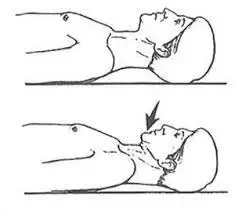
- Isometric neck exercise in a Supine lying position:
- To perform an isometric neck exercise in a supine lying down posture, lie on your back on a plinth or mattress with a small cushion or rolled towel behind your head and your hands by your sides.
- Neck flexion
- In the Prone Position, the pillow is kept under your head
- Press the pillow or hold it for 5 to 10 seconds.
- Neck extension
- For this exercise, lie down on your back over a plinth or a mattress, with a small cushion or a wrapped towel beneath your head and your hand by your side.
- Push the pillow on the back of your head or hold it for 5 to 10 seconds.
- Neck side flexion
- This workout requires you to lie on either your right or left side.
- Take a cushion underneath your head and slowly push it closer to the plinth.
- Hold this for 5 to 10 secs.
- Perform this on the right side.
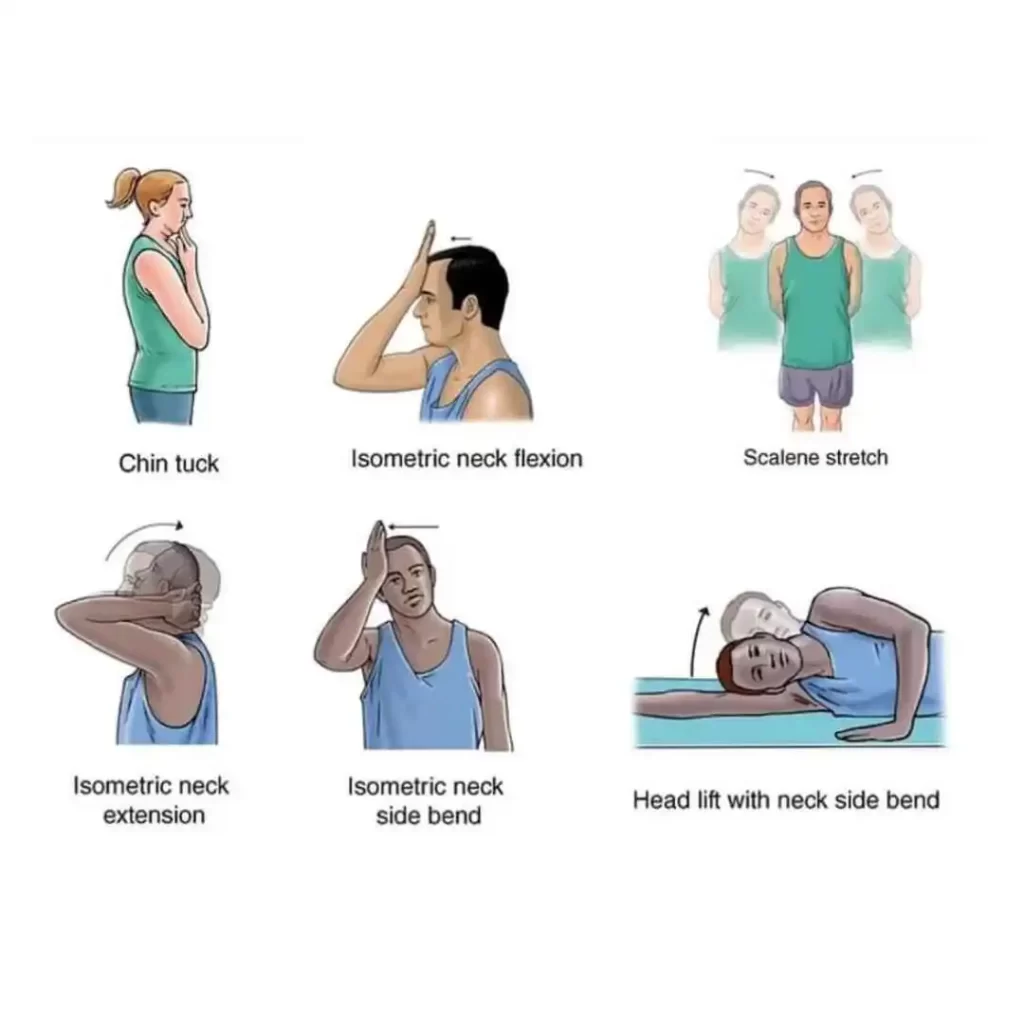
- Strengthening Exercises: Strengthening the muscles around the neck, shoulders, and upper back can help provide support to the spine and reduce strain on the nerves. Examples include:
- Neck Retraction: Gently pull your head backward as if making a double chin, then relax.
- Shoulder Blade Squeezes: Sit or stand with your hands at your sides and push your shoulder blades together.
- Scapular Stabilization Exercises: These exercises target the muscles that support the shoulder blades and upper back.
Exercise for lumbar spinal stenosis
- Lumbar flexion exercise: most people get relief from lumbar flexion exercise as it increases the space within the spinal canal however sometimes few people get also relief from back extension exercise.
- Lumbar flexion in sitting and standing positions: Bending forward increases the range of motion in the lumbar spine.
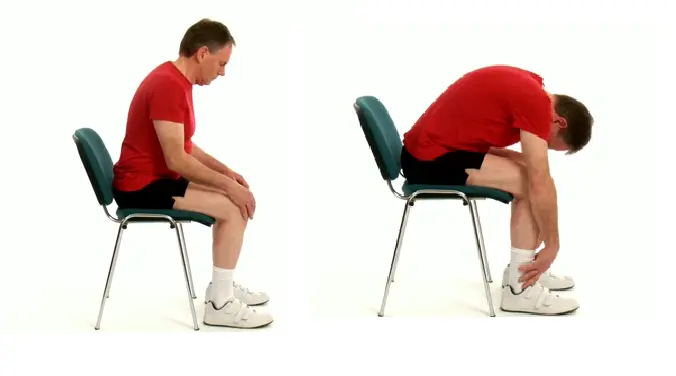
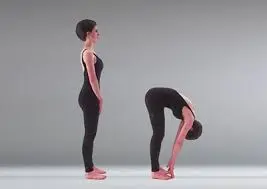
- hip flexion-extension exercise: In the supine position, hips flex, while in the prone position, hips extend.
- Lumbar flexion with rotation (lower trunk rotation): The rotating feature of this stretch improves spinal mobility. It allows for greater rotation and movement between the vertebrae, which can release the compressed nerve and contribute to a healthier and more functional spine
- Knee to chest
- this exercise will increase the strength of the lower back muscle and help to improve the full range of motion in both the pelvis and lower back vertebrae.
- this exercise loosens up any stiffness and improves posture
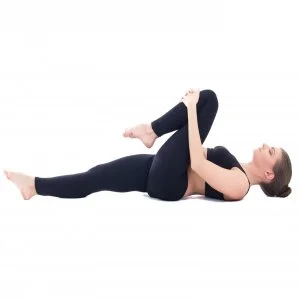
- Pelvic tilts
- activate pelvic floor muscles and strengthen your abdominal muscles. and improve lumbar stability.
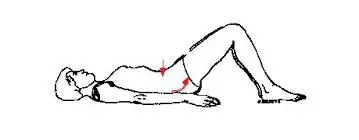
- curl-ups
- cat and cow The cat-cow is a mobilization of the lower back area, to bring proper movement into the lower back and pelvis.
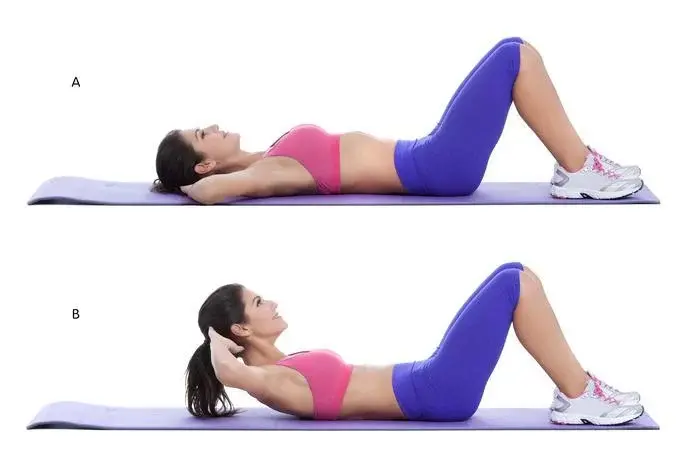
- cat and cow
- This is a well-known and effective vital movement.
- Improves posture and balance.
- Strengthens and stretches the spine and neck.
- Stretches the hips, abdomen, and back.
- Increases coordination.
- Provides massages and activates organs in the abdomen, including the kidneys and adrenal glands.
- Creates emotional balance.
- This is a well-known and effective vital movement.
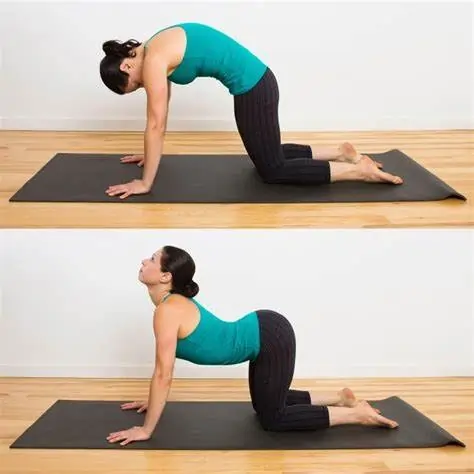
Surgical management for spinal stenosis
Spinal stenosis is a difficult condition, and your spine is a sensitive structure. As a result, physicians only decide on surgery after exhausting all other therapy options. Fortunately, most persons with spinal stenosis do not require surgery.
Types of spine surgery include:
- Laminectomy (decompression surgery): This is the most frequent surgical procedure for spinal stenosis. It involves cutting off the lamina, a section of your vertebra. In addition, the surgeon may remove certain ligaments and bone spurs. The operation increases the space available for your spinal cord and nerves.
- Laminotomy: The surgeon simply removes the little part of the lamina that is putting the most pressure on the nerve.
- Laminoplasty: The surgeon removes a portion of the lamina to provide additional canal space. They employ metal plates and screws to form a hinged bridge over the region where the bone was removed.
- Foraminotomy: The foramen is the space in your vertebrae where nerve roots leave. This technique includes removing bone or tissue in this location to make room for the nerve roots.
- Interspinous process spacers: This is a minimally invasive procedure for certain persons with lumbar spinal stenosis. The surgeon inserts spacers between the spinous processes, which are the bones that protrude from the back of each vertebra. The spacers hold your vertebrae apart, allowing more room for nerves.
- Spinal fusion: Healthcare practitioners often use spinal fusion as a last option. If your spinal canal stenosis is causing nerve pain and medical treatment, or physical therapy has failed, they will only consider it. Two vertebrae are permanently joined via spinal fusion surgery.
- Needle procedure for thicker ligaments: Sometimes the ligament at the back of the lumbar spine becomes overly thick. A needle-like instrument put through the skin can remove portions of the ligament. This can increase room in the spinal canal, reducing pressure on nerve roots. You may be given medicine to help you relax during treatment. A lot of people can return home on the same day.
Prevention
Can I prevent spinal stenosis?
Spinal stenosis cannot be prevented because the majority of its causes are normal age-related “wear and tear” issues. However, you may take basic precautions to maintain your spine healthy. They may help to lessen your chances of developing spinal stenosis. These steps include:
You are eating healthful meals. Make sure your diet has enough calcium to keep your bones healthy.
Maintaining a healthy body weight.
Avoiding or stopping smoking. Smoking causes artery damage, which can lead to back discomfort and make it harder for injuries to heal.
Practicing proper posture.
Exercise regularly. Maintaining muscular strength, particularly in the back and core, helps to maintain your spine healthy.
Spinal canal stenosis cannot be relieved permanently, however lifestyle changes can lower the risk of it. Health practitioners promote lowering the risk of spinal stenosis.
- Regular exercise helps to strengthen the muscles that support the spine and back.
- Maintaining a healthy body weight. Excess weight puts additional strain on the spine and may eventually lead to the development of spinal stenosis.
- Avoiding misuse of the spine, such as lifting heavy objects.
- Cigarette smoking should also be avoided due to its substantial association with degenerative disc disorders.
FAQs
What are the severe symptoms of spinal stenosis?
If the spinal cord gets compressed due to spinal stenosis, you may feel pain, numbness, or other symptoms. In extreme situations, it might result in a lack of bowel or bladder control and restricted movement.
What is spinal stenosis pain like?
Spinal stenosis symptoms include pain, stiffness, tingling, and numbness. The pain may be heat or hurting, and it is worse when walking, sitting, or standing. These symptoms can go down the leg, arm, or buttocks, depending on which portion of the spine is afflicted.
What position relieves spinal stenosis?
Sleeping on your side with your knees curled up (in the fetal position) may be preferred for this problem. This helps to reduce strain on the nerve roots. Sleeping in a reclining chair or adjustable bed with the head and legs elevated might also help to reduce nerve pressure.
References
- Exercises for lumbar spinal stenosis. (n.d.). Jacksonville Orthopaedic Institute. https://www.joionline.net/trending/content/exercises-lumbar-stenosis
- Mfa, J. H. M. M. (2023, September 22). Spinal stenosis. Healthline. https://www.healthline.com/health/spinal-stenosis#outlook
- Bjerke, B., MD. (n.d.). What is spinal stenosis? Spine-health. https://www.spine-health.com/conditions/spinal-stenosis/what-spinal-stenosis
- Spinal stenosis – Diagnosis and treatment – Mayo Clinic. (2023, March 28). https://www.mayoclinic.org/diseases-conditions/spinal-stenosis/diagnosis-treatment/drc-20352966
- Branch, N. S. C. a. O. (2023, December 15). Spinal stenosis. National Institute of Arthritis and Musculoskeletal and Skin Diseases. https://www.niams.nih.gov/health-topics/spinal-stenosis
- Spinal stenosis – Symptoms and causes – Mayo Clinic. (2023, March 28). Mayo Clinic. https://www.mayoclinic.org/diseases-conditions/spinal-stenosis/symptoms-causes/syc-20352961
- Lumbar spinal stenosis – OrthoInfo – AAOS. (n.d.). https://orthoinfo.aaos.org/en/diseases–conditions/lumbar-spinal-stenosis
- Spinal stenosis: MedlinePlus Medical Encyclopedia. (n.d.). https://medlineplus.gov/ency/article/000441.htm
- Ms, M. B. F. M. (n.d.). Spinal Stenosis: Practice Essentials, anatomy, pathophysiology. https://emedicine.medscape.com/article/1913265-overview?form=fpf
- Spire Healthcare. (n.d.). Spinal stenosis Symptoms causes & treatment | Spire Healthcare. https://www.spirehealthcare.com/conditions/spinal-stenosis/
- Spinal stenosis. (2023, July 6). Yale Medicine. https://www.yalemedicine.org/conditions/spinal-stenosis
- Spinal stenosis. (n.d.). NYU Langone Health. https://nyulangone.org/conditions/spinal-stenosis
- Medtronic. (n.d.). Spinal conditions – stenosis. Medtronic. https://www.medtronic.com/us-en/patients/conditions/back-pain/causes/stenosis.html
- Spinal Stenosis | Spine Center | OHSU. (n.d.). https://www.ohsu.edu/spine-center/spinal-stenosis
- Tyneside Integrated Musculoskeletal Service. (n.d.). Tyneside Integrated musculoskeletal service information for patients. https://www.tims.nhs.uk/wp-content/uploads/2020/06/1.8-TIMS-Spinal-Stenosis.pdf

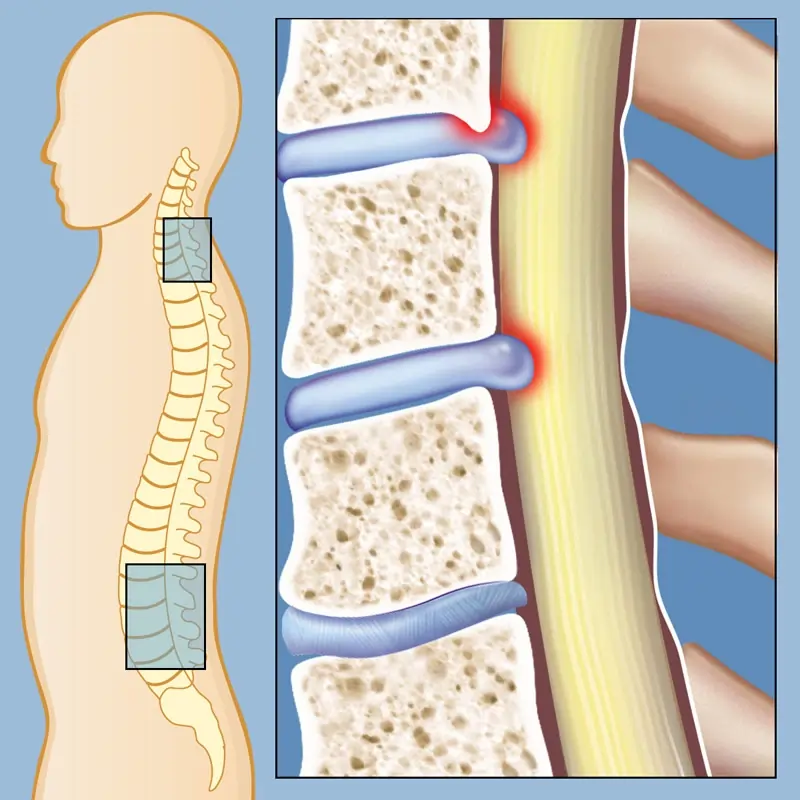
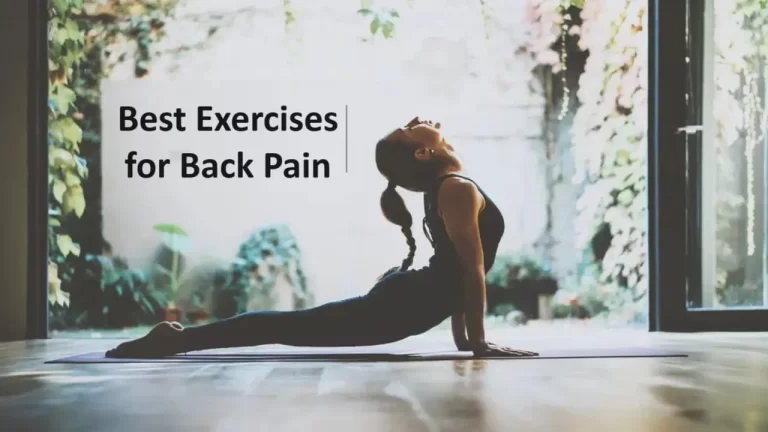
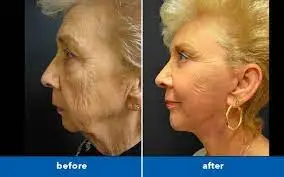
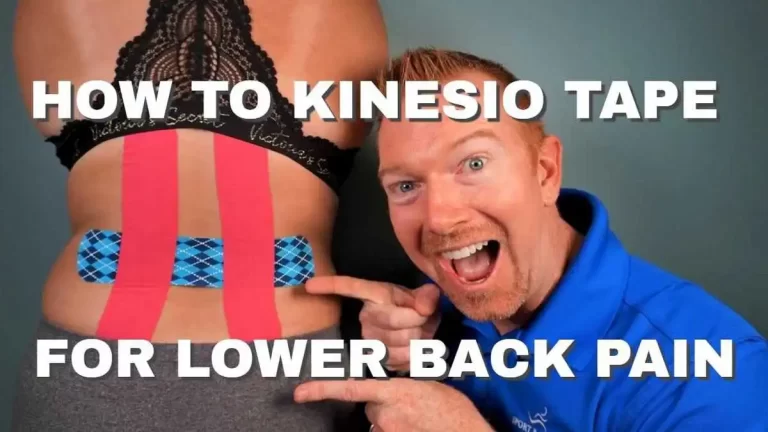

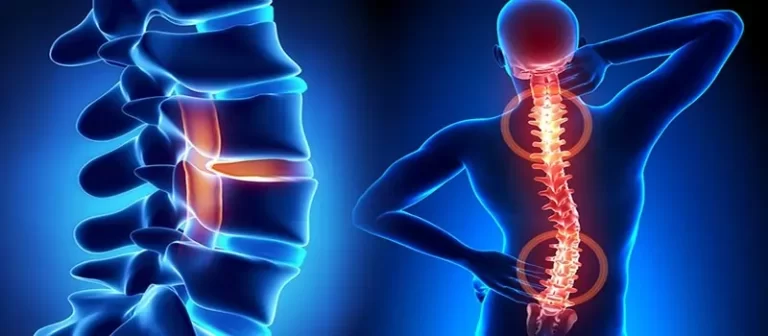
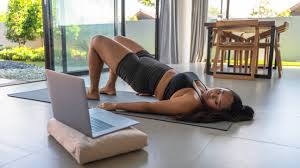
2 Comments